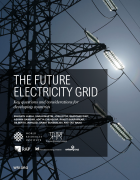The Future Electricity Grid
Key Questions and Considerations for Developing Countries
by -Renewable energy (RE) is growing worldwide, with a six-fold increase in non-hydro renewables over the last decade from 85 to 657 gigawatts (GW). This report reviews the key trends that explain growth in RE, and highlights how they are challenging decision making in countries such as Brazil, China, India, and Kyrgyzstan.
Key Findings
Executive Summary
Changes in the sector, driven in part by objectives such as energy security, socio-economic development, increasing sustainable energy, environmental protection, climate change mitigation, public health, and increased public choice, are causing a number of trends: new and disruptive technologies, including variable renewable energy, small distributed generation and storage, are being deployed; new players such as individual homeowners and communities, are arising as legitimate electricity generators; and overall market dynamics are changing with the introduction of policy support mechanisms for clean energy, and increased competition. With these changes a new set of questions are arising regarding technical, institutional, and economic restructuring necessary to integrate these changes, and turn potential system wide threats into opportunities.
These changes are not only happening in developed countries but developing countries such as India as well. This report reviews how these trends are challenging the current state of play and how system planners, electric utilities, regulators, consumers and policy makers in Brazil, China, India and Kyrgyzstan can proactively start to plan for the transition towards the future grid.


